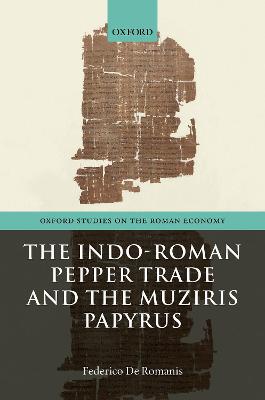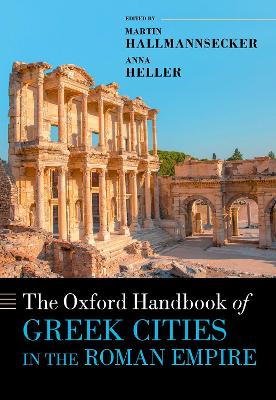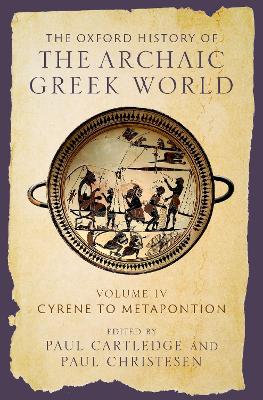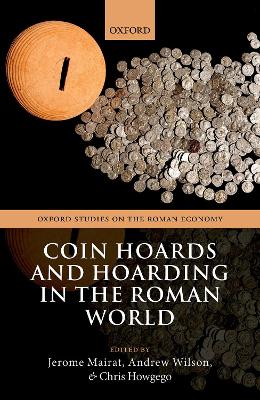Indo-Roman Pepper Trade and the Muziris Papyrus
 -10%
portes grátis
-10%
portes grátis
Indo-Roman Pepper Trade and the Muziris Papyrus
De Romanis, Federico
Oxford University Press
04/2020
408
Dura
Inglês
9780198842347
15 a 20 dias
778
Descrição não disponível.
Frontmatter
List of Figures
List of Tables
List of Abbreviations
0: Introduction
0.1. Synopsis
P. Vindob. G 40822: Text and Translation
Part I. Contextualizing the Muziris Papyrus
1: Bridging Disconnected Seas
1.1. Challenges
1.2. The Northern Passages
1.3. The Southern Passages
1.4. Multifaceted Complementarity
2: Riding the Monsoons
2.1. Direct Sea Routes
2.2. Multi-Stage Sea Routes
2.3. Heading for India
2.4. The Pleiades in the Middle of the Yard
3: Pepper Lands
3.1. Kottanarike, the Southern Pepper-Producing Land
3.2. Male, the Northern Pepper-Producing Land
3.3. Early Modern Quantitative Dimensions
3.4. Ancient Prices
4: South Indian Perspectives
4.1. Gatherers
4.2. Traders
4.3. Kings
4.4. The Pepper Pendulum
5: Supporting Sources
5.1. Strabo: The Customs Duties on Indian Commodities
5.2. The Periplus: The Ships and Cargoes of the South India Trade
5.3. Pliny: The Schedule of the Commercial Enterprises to South India
5.4. Ptolemy: The Evolution of the South Indian Context
Part II. Let Him Look to his Bond: A Loan Contract for Muziris (P. Vindob. G 40822 Recto)
6: Deadline and Whereabouts
6.1. A Debated Contract
6.2. Time and Maritime Loans
6.3. The Deadline for Repayment of the Muziris Loan Contracts
6.4. In the Beginning Was the Loan Contract
7: Selling and Repaying
7.1. Repaying a Maritime Loan in Fourth-Century BC Athens
7.2. Under the Lender's Power and Seal
7.3. Earnings and Benefit of Assumption
7.4. Outstanding Loans
8: Loan and Logistics
8.1. What the Loan Was All About
8.2. Prudent Loans for Maritime Trade
8.3. Caravans from Berenice
8.4. The Coptos Ships
8.5. Late Medieval Comparanda
Part III. The Muziris Cargo of a Roman Indiaman (P. Vindob. G 40822 Verso)
9: Three Minor Cargoes and How They Were Assessed
9.1. Three Quarters of an Indiaman's Cargo
9.2. Gangetic Nard
9.3. Schidai
9.4. Straightforward and Circuitous Evaluations
9.5. Cargoes, Quarters, and the Arabarchs' Additional Shares
10: The Other Cargoes
10.1. Col. ii, ll. 14-30: An Overview
10.2. Pepper: Col. ii, ll. 20-30 (and ll. 1-3)
10.3. Tortoise Shell (?) and Malabathron: Col. ii, ll. 14-19
11: Contrasts
11.1. Ancient and Early Modern Pepper Carriers
11.2. Another Pepper Trade
11.3. Conspicuous Absences
11.4. Indian and African Tusks
Part IV. The Red Sea Tax and the Muziris Papyrus
12: Maris Rubri Vectigal
12.1. Payments in Kind and Payments in Money
12.2. Double Customs Duties on Different Tax Bases
12.3. Rates
12.4. Fiscal Values
12.5. Weight Standards
13: Dramatis Personae
13.1. Arabarchs, Paralemptai, and Grammateis
13.2. A Lender/Customs Collector
13.3. A Borrower/Ship Owner
13.4. The Imperial Administration
14: Epilogue
Appendices
1. Exchanging Coins at Barygaza
2. Axum and Silis in the Kephalaia: Trade and Powers in the Late Antique Indian Ocean
Endmatter
References
Index
List of Figures
List of Tables
List of Abbreviations
0: Introduction
0.1. Synopsis
P. Vindob. G 40822: Text and Translation
Part I. Contextualizing the Muziris Papyrus
1: Bridging Disconnected Seas
1.1. Challenges
1.2. The Northern Passages
1.3. The Southern Passages
1.4. Multifaceted Complementarity
2: Riding the Monsoons
2.1. Direct Sea Routes
2.2. Multi-Stage Sea Routes
2.3. Heading for India
2.4. The Pleiades in the Middle of the Yard
3: Pepper Lands
3.1. Kottanarike, the Southern Pepper-Producing Land
3.2. Male, the Northern Pepper-Producing Land
3.3. Early Modern Quantitative Dimensions
3.4. Ancient Prices
4: South Indian Perspectives
4.1. Gatherers
4.2. Traders
4.3. Kings
4.4. The Pepper Pendulum
5: Supporting Sources
5.1. Strabo: The Customs Duties on Indian Commodities
5.2. The Periplus: The Ships and Cargoes of the South India Trade
5.3. Pliny: The Schedule of the Commercial Enterprises to South India
5.4. Ptolemy: The Evolution of the South Indian Context
Part II. Let Him Look to his Bond: A Loan Contract for Muziris (P. Vindob. G 40822 Recto)
6: Deadline and Whereabouts
6.1. A Debated Contract
6.2. Time and Maritime Loans
6.3. The Deadline for Repayment of the Muziris Loan Contracts
6.4. In the Beginning Was the Loan Contract
7: Selling and Repaying
7.1. Repaying a Maritime Loan in Fourth-Century BC Athens
7.2. Under the Lender's Power and Seal
7.3. Earnings and Benefit of Assumption
7.4. Outstanding Loans
8: Loan and Logistics
8.1. What the Loan Was All About
8.2. Prudent Loans for Maritime Trade
8.3. Caravans from Berenice
8.4. The Coptos Ships
8.5. Late Medieval Comparanda
Part III. The Muziris Cargo of a Roman Indiaman (P. Vindob. G 40822 Verso)
9: Three Minor Cargoes and How They Were Assessed
9.1. Three Quarters of an Indiaman's Cargo
9.2. Gangetic Nard
9.3. Schidai
9.4. Straightforward and Circuitous Evaluations
9.5. Cargoes, Quarters, and the Arabarchs' Additional Shares
10: The Other Cargoes
10.1. Col. ii, ll. 14-30: An Overview
10.2. Pepper: Col. ii, ll. 20-30 (and ll. 1-3)
10.3. Tortoise Shell (?) and Malabathron: Col. ii, ll. 14-19
11: Contrasts
11.1. Ancient and Early Modern Pepper Carriers
11.2. Another Pepper Trade
11.3. Conspicuous Absences
11.4. Indian and African Tusks
Part IV. The Red Sea Tax and the Muziris Papyrus
12: Maris Rubri Vectigal
12.1. Payments in Kind and Payments in Money
12.2. Double Customs Duties on Different Tax Bases
12.3. Rates
12.4. Fiscal Values
12.5. Weight Standards
13: Dramatis Personae
13.1. Arabarchs, Paralemptai, and Grammateis
13.2. A Lender/Customs Collector
13.3. A Borrower/Ship Owner
13.4. The Imperial Administration
14: Epilogue
Appendices
1. Exchanging Coins at Barygaza
2. Axum and Silis in the Kephalaia: Trade and Powers in the Late Antique Indian Ocean
Endmatter
References
Index
Este título pertence ao(s) assunto(s) indicados(s). Para ver outros títulos clique no assunto desejado.
Frontmatter
List of Figures
List of Tables
List of Abbreviations
0: Introduction
0.1. Synopsis
P. Vindob. G 40822: Text and Translation
Part I. Contextualizing the Muziris Papyrus
1: Bridging Disconnected Seas
1.1. Challenges
1.2. The Northern Passages
1.3. The Southern Passages
1.4. Multifaceted Complementarity
2: Riding the Monsoons
2.1. Direct Sea Routes
2.2. Multi-Stage Sea Routes
2.3. Heading for India
2.4. The Pleiades in the Middle of the Yard
3: Pepper Lands
3.1. Kottanarike, the Southern Pepper-Producing Land
3.2. Male, the Northern Pepper-Producing Land
3.3. Early Modern Quantitative Dimensions
3.4. Ancient Prices
4: South Indian Perspectives
4.1. Gatherers
4.2. Traders
4.3. Kings
4.4. The Pepper Pendulum
5: Supporting Sources
5.1. Strabo: The Customs Duties on Indian Commodities
5.2. The Periplus: The Ships and Cargoes of the South India Trade
5.3. Pliny: The Schedule of the Commercial Enterprises to South India
5.4. Ptolemy: The Evolution of the South Indian Context
Part II. Let Him Look to his Bond: A Loan Contract for Muziris (P. Vindob. G 40822 Recto)
6: Deadline and Whereabouts
6.1. A Debated Contract
6.2. Time and Maritime Loans
6.3. The Deadline for Repayment of the Muziris Loan Contracts
6.4. In the Beginning Was the Loan Contract
7: Selling and Repaying
7.1. Repaying a Maritime Loan in Fourth-Century BC Athens
7.2. Under the Lender's Power and Seal
7.3. Earnings and Benefit of Assumption
7.4. Outstanding Loans
8: Loan and Logistics
8.1. What the Loan Was All About
8.2. Prudent Loans for Maritime Trade
8.3. Caravans from Berenice
8.4. The Coptos Ships
8.5. Late Medieval Comparanda
Part III. The Muziris Cargo of a Roman Indiaman (P. Vindob. G 40822 Verso)
9: Three Minor Cargoes and How They Were Assessed
9.1. Three Quarters of an Indiaman's Cargo
9.2. Gangetic Nard
9.3. Schidai
9.4. Straightforward and Circuitous Evaluations
9.5. Cargoes, Quarters, and the Arabarchs' Additional Shares
10: The Other Cargoes
10.1. Col. ii, ll. 14-30: An Overview
10.2. Pepper: Col. ii, ll. 20-30 (and ll. 1-3)
10.3. Tortoise Shell (?) and Malabathron: Col. ii, ll. 14-19
11: Contrasts
11.1. Ancient and Early Modern Pepper Carriers
11.2. Another Pepper Trade
11.3. Conspicuous Absences
11.4. Indian and African Tusks
Part IV. The Red Sea Tax and the Muziris Papyrus
12: Maris Rubri Vectigal
12.1. Payments in Kind and Payments in Money
12.2. Double Customs Duties on Different Tax Bases
12.3. Rates
12.4. Fiscal Values
12.5. Weight Standards
13: Dramatis Personae
13.1. Arabarchs, Paralemptai, and Grammateis
13.2. A Lender/Customs Collector
13.3. A Borrower/Ship Owner
13.4. The Imperial Administration
14: Epilogue
Appendices
1. Exchanging Coins at Barygaza
2. Axum and Silis in the Kephalaia: Trade and Powers in the Late Antique Indian Ocean
Endmatter
References
Index
List of Figures
List of Tables
List of Abbreviations
0: Introduction
0.1. Synopsis
P. Vindob. G 40822: Text and Translation
Part I. Contextualizing the Muziris Papyrus
1: Bridging Disconnected Seas
1.1. Challenges
1.2. The Northern Passages
1.3. The Southern Passages
1.4. Multifaceted Complementarity
2: Riding the Monsoons
2.1. Direct Sea Routes
2.2. Multi-Stage Sea Routes
2.3. Heading for India
2.4. The Pleiades in the Middle of the Yard
3: Pepper Lands
3.1. Kottanarike, the Southern Pepper-Producing Land
3.2. Male, the Northern Pepper-Producing Land
3.3. Early Modern Quantitative Dimensions
3.4. Ancient Prices
4: South Indian Perspectives
4.1. Gatherers
4.2. Traders
4.3. Kings
4.4. The Pepper Pendulum
5: Supporting Sources
5.1. Strabo: The Customs Duties on Indian Commodities
5.2. The Periplus: The Ships and Cargoes of the South India Trade
5.3. Pliny: The Schedule of the Commercial Enterprises to South India
5.4. Ptolemy: The Evolution of the South Indian Context
Part II. Let Him Look to his Bond: A Loan Contract for Muziris (P. Vindob. G 40822 Recto)
6: Deadline and Whereabouts
6.1. A Debated Contract
6.2. Time and Maritime Loans
6.3. The Deadline for Repayment of the Muziris Loan Contracts
6.4. In the Beginning Was the Loan Contract
7: Selling and Repaying
7.1. Repaying a Maritime Loan in Fourth-Century BC Athens
7.2. Under the Lender's Power and Seal
7.3. Earnings and Benefit of Assumption
7.4. Outstanding Loans
8: Loan and Logistics
8.1. What the Loan Was All About
8.2. Prudent Loans for Maritime Trade
8.3. Caravans from Berenice
8.4. The Coptos Ships
8.5. Late Medieval Comparanda
Part III. The Muziris Cargo of a Roman Indiaman (P. Vindob. G 40822 Verso)
9: Three Minor Cargoes and How They Were Assessed
9.1. Three Quarters of an Indiaman's Cargo
9.2. Gangetic Nard
9.3. Schidai
9.4. Straightforward and Circuitous Evaluations
9.5. Cargoes, Quarters, and the Arabarchs' Additional Shares
10: The Other Cargoes
10.1. Col. ii, ll. 14-30: An Overview
10.2. Pepper: Col. ii, ll. 20-30 (and ll. 1-3)
10.3. Tortoise Shell (?) and Malabathron: Col. ii, ll. 14-19
11: Contrasts
11.1. Ancient and Early Modern Pepper Carriers
11.2. Another Pepper Trade
11.3. Conspicuous Absences
11.4. Indian and African Tusks
Part IV. The Red Sea Tax and the Muziris Papyrus
12: Maris Rubri Vectigal
12.1. Payments in Kind and Payments in Money
12.2. Double Customs Duties on Different Tax Bases
12.3. Rates
12.4. Fiscal Values
12.5. Weight Standards
13: Dramatis Personae
13.1. Arabarchs, Paralemptai, and Grammateis
13.2. A Lender/Customs Collector
13.3. A Borrower/Ship Owner
13.4. The Imperial Administration
14: Epilogue
Appendices
1. Exchanging Coins at Barygaza
2. Axum and Silis in the Kephalaia: Trade and Powers in the Late Antique Indian Ocean
Endmatter
References
Index
Este título pertence ao(s) assunto(s) indicados(s). Para ver outros títulos clique no assunto desejado.







